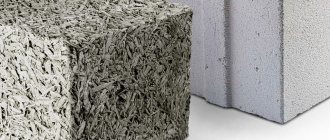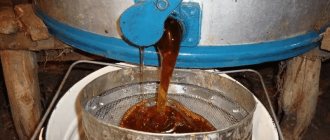A part such as a siphon is made of various materials. The most popular options today are plastic and metal. Of course, plastic parts are cheaper and more common, but stainless steel siphons last longer and are less susceptible to mechanical damage.
Today in plumbing stores you can find not only standard manual siphons, but also automatic and semi-automatic siphons. According to consumers, using such products is more convenient. The main thing is to choose a suitable model with a reliable and durable automatic mechanism.
Modern siphons are distinguished by a wealth of choice. The range of these parts allows you to choose an ideal and durable copy that will serve without causing any problems.
Installation of bath siphons
The design of most siphons consists of two parts: 1) drain block; 2) overflow block.
- The drain pipe is used for direct drainage of water and is attached to the bottom of the bathtub bottom.
- The overflow block serves to protect against water overflowing over the edges of the bathtub, so the pipe opening is located on top not far from the edges.
A bathroom drain using a siphon ensures proper water circulation and also blocks unpleasant odors from the sewer. This design has 4 parts: a neck, a pipe, an overflow corrugated hose, a soft or hard pipe that directly connects to the sewer.
The neck is directly attached to the bottom of the bathtub on both sides using a metal screw, which tightly tightens the inner and outer parts. During installation, it is important to ensure tightness using a rubber seal. The overflow neck has a side outlet through which water flows in a stream under low pressure.
The siphon pipe has a curved shape, which ensures that a certain amount of water is always inside. This water barrier prevents the movement of odors from the sewer system. To effectively perform these functions, the volume of liquid must be at least 300-400 ml, since with a small volume of water it can be automatically sucked into the sewage system.
The corrugated hose drains excess water, preventing possible overflows from the top. However, due to the low pressure of liquids, it is not necessary to use crimp structures.
The connection to the sewer can be made using more reliable hard or soft corrugated tubes, which can be adjusted in length.
When assembling a complete structure, flat or conical gaskets, screws and union nuts are used. It is important to consider that the thinner part of the gasket should go into the adjacent pipe towards the sewer.
Today, the sanitary equipment market offers drainage structures for individual baths in three main varieties:
- conventional mechanical system with plug;
- semi-automatic bath siphon;
- automatic connection for bathtub.
Classification of types of drain mechanism
Three types of devices are considered and each has its own design features.
Standard type device
This simplest design is represented by components:
- a siphon is represented by a pipe. It stops the penetration of unpleasant odors into the room;
- drain hole for overflow;
- liquid outlet hole at the bottom of the bowl;
- connecting tube for siphon and sewer pipe;
- The liquid is poured through a corrugated pipe into the siphon.
The mechanism is called traditional. When the drain neck is closed with a stopper, water is drawn into the tank.
Operational problems may arise with rubber gaskets. They change periodically. The price of a standard mechanism is 10-25 dollars.
It is classified as a reliable mechanism, since there are no moving elements in its design. The simple drain design is easy to assemble and install yourself.
Differences between automatic and semi-automatic mechanisms
Structurally, the drainage mechanism for the bathtub is designed in two types:
- automatic bath drain;
- semi-automatic in the bathroom.
Automatic bath drain
The device is also called “click-click”. The system works very simply. At the bottom of the bowl there is a button that starts the automatic siphon. The first press of the button opens the drain, the second press closes it. The operation of the mechanism depends on the spring that is attached to the system plug.
Types of siphons depending on design
Depending on the design, there are the following types of these products.
Flat. The design of such a device allows for their installation in limited space. The main part of the device, in which a water seal is formed and debris accumulates, is located horizontally. In order to clean the flat bath siphon, it is necessary to partially dismantle it.
Flat siphon - ideal for installation in confined spaces
Pipe. Such devices are made from pipe sections of different lengths, joined in a certain sequence. Pipes in this design have sufficient rigidity. This bathroom siphon is more compact than the previous type, however, due to the lack of a compartment in which debris is concentrated, cleaning it is more difficult.
Bottled. This type is distinguished by the presence of a special compartment, which is shaped like a bottle (hence the name). Garbage is collected in this compartment, and there is also a water seal in it. Bottle siphons are quite large in size compared to other types, so their installation is only possible if there is enough free space under the bathtub. Such devices can be periodically cleaned without completely disassembling the structure, which is very convenient.
Corrugated. They are distinguished by the simplest design, which includes a “drain-overflow” type device and a soft pipe. The pipe can be bent in any desired direction. A corrugated siphon for a bathtub has one drawback - the rapid formation of a blockage. This is due to the fact that the ribbed walls trap foreign particles. In addition, connecting the overflow element often causes difficulties.
Options for constructive solutions for strapping
Bath frames are classified according to two criteria: by design and material of manufacture. If we take design differences as a basis, we distinguish: universal, semi-automatic and automatic systems.
Universal
The simplest version of the piping is often used when connecting and installing bathtubs of any type: acrylic, steel, cast iron.
The main requirement for installing a universal system is that the distance from the center of the overflow to the drain hole is no more than 57.5 cm
The main elements of the system are:
- Drain neck. It is equipped with a metal plate intended for installing the cover.
- Overflow neck. It has the same design overlay.
- Siphon. An element that ensures water flow and prevents the spread of sewer “odors.” It can have a collapsible or monolithic body.
- Corrugated hose. It is designed to connect the drain and overflow necks and is mounted by pulling it onto the fitting or tightening the union nuts.
The outer part of the overflow is decorated with a grille, and the return part is connected to the receiving block. A spout tube is attached to it, connected to a pipe coming from the lower outlet.
Regulation of water release in universal piping models is carried out by manually removing the plug tied on a chain
Among the presented types, the universal harness, which includes a minimum of movable elements, is considered the most reliable and durable.
Semi-automatic
The peculiarity of the system is that it is equipped with a rotating lever, with the help of which the drain neck is blocked. This mechanism is convenient to operate even while lying in the bathroom. You just need to get used to it, learning to move the lever with your toe.
The operation of the semi-automatic bathtub harness is based on the mechanical principle. The device is driven by a rotation lever or valve installed on the siphon overflow neck. The starting lever, similar to a bicycle gearshift, is connected by a cable to another lever located in the drain neck of the device.
By turning the rotation lever in one direction or another, the cable is tightened or, on the contrary, weakened, under the action of which the plug located above the drain hole is lowered or raised.
The main advantage of such a system is ease of use: to lift the plug and drain the water, you don’t have to bend over into the bathtub
Consumers who have installed semi-automatic drainage systems in their bathrooms complain about the fragility of the design. All you have to do is press a little harder on the plastic lever and it may break.
Automatic system
Automatic systems are devoid of any cables or fragile elements. The drain neck is opened by pressing the plug.
Under the action of a spring, supplemented by a latch, the plug, when pressed, easily rises above the surface, ensuring free flow of water. When pressed again, it lowers, covering the neck of the drain hole.
External accessories for an automatic bathtub can be made in any color: white, painted bronze, gold or silver metal
The disadvantages of the system include only the small size of the hole that remains under the drain plug. Hair and small debris often accumulate in it, making it difficult to drain the water.
In low-quality products, the increased complexity of the design often leads to breakdowns, which cannot always be repaired. And the problem can be eliminated only by completely replacing the automatic system.
To protect yourself from unexpected expenses, choose equipment from trusted manufacturers. The best choice is automatic bath trims made of metal.
Types of siphons according to the method of water discharge
There are the following types of siphons according to the method of water discharge:
- manual;
- semi-automatic;
- automatic.
Automatic siphons are complex devices, but they make it easier to control the water level in the bathtub
Manual. The design of such devices is considered the simplest. These devices are equipped with a drain hole that is manually adjustable (opens and closes).
Semi-automatic. Semi-automatic devices at the manufacturing stage are equipped with a special plug with an additional cable. This plug is adjusted using a handle located outside the bathtub. As a rule, such a handle has two positions: directly draining water from the bathtub or placing a load on the overflow hole.
Automatic (click-clack devices). Such devices are the most complex in terms of execution. The automatic bathtub is able to independently regulate the water level in the bathtub bowl. In order to drain the water, in this case you just need to press the drain lid.
Important! Experts do not recommend installing automatic models yourself. This is due to the fact that their installation requires special knowledge and high precision, otherwise such a system will be ineffective.
Breaking down a cast iron bathtub for removal in parts ↑
If you need to dismantle an old bathtub and install a new one, then the easiest and fastest way to get rid of outdated plumbing fixtures is to simply break them apart with a sledgehammer. Cast iron is a strong metal, but it cannot withstand a series of strong blows from a heavy hammer and will definitely crack. After this, it will not be difficult for even one person to remove small pieces from the apartment.
The only significant drawback of this method is the extreme noise produced during the breaking process. To reduce the need for knocking, you can use a grinder. The procedure will be as follows:
- As in the previous case, disconnect the plumbing from the communications, cut or otherwise dismantle the drain pipe.
- Free the bathtub from cement mortar around the perimeter. If there is a decorative screen, then it is broken with a chisel and hammer.
- Move the bowl a little away from the edge of the wall. Using a grinder, make cuts on the curved edges in the middle on both sides. It is these edges that give the bowl the necessary rigidity, so you need to saw them completely.
Next, all that remains is to hit the bottom with a sledgehammer a couple of times, after which the bathtub will “fold” exactly in the middle. The only thing that should not be forgotten throughout the entire demolition of sanitary equipment is eye protection. Use special masks or goggles, otherwise chipped pieces of enamel or shavings can cause injury.
Video: How to break a cast iron bathtub ↑
The work of dismantling communications, demolishing and removing an old bathtub is not extremely difficult, although its labor intensity for one person is quite significant. The greatest difficulty is caused by dismantling a cast iron drain, the stuck nut of which is almost impossible to unscrew without the help of, for example, a hammer drill. Breaking will also require significant physical effort, so it is better to do the work with an assistant or immediately seek help from a specialist.
Video: Complete elimination of plumbing systems using an angle grinder ↑
Materials used for the manufacture of siphons
For the manufacture of siphons the following are used:
- plastic. Plastic devices are durable and low cost. It is optimal to install such equipment on a bathtub with a protective screen, since the appearance of the device is not aesthetic;
- metal: brass, bronze, chrome steel and so on. Metal siphons are suitable for acrylic bathtubs, especially those installed in the center of the bathroom. The devices, having an elegant and neat appearance, can serve as additional elements of room decor;
Siphon made of copper and brass
- cast iron. Siphons made of cast iron are intended exclusively for bathtubs made of the same material. Currently, they are practically not used, as they are large in weight and size, and also require high installation accuracy.
Device made of cast iron
If the siphon is not visible to users, then it is enough to install a plastic device.
Practical advice
Siphon installation
The purchased drainage system must be convenient and reliable, which must be taken care of in advance. When making a choice, it is important to pay attention to the following:
- The drain mechanism can be controlled by a valve, button or handle. Decide in advance and firmly decide which mechanism will suit you and be most convenient. If it’s hard to imagine, then you can go to a plumbing store and ask the seller to show different models.
- If you purchase a metal drain-overflow system, you definitely need to find out what metal it is made of. Some manufacturers of silumin products spray them and in appearance they are very similar to brass products.
- A white bathtub will harmonize with any colors of siphon lids. The main thing is that there is no clutter and disharmony with the style of the room.
- Automatic or semi-automatic? Don’t rush to make a decision just after hearing the word machine. The method of draining is fundamentally different. In an automatic system, in order to activate the drain mechanism, you need to apply force to the lid covering the drain hole. If you need to drain the water while taking a bath, then there is no problem. The semi-automatic system controls the drainage system from the outside.
- When choosing a semi-automatic system, it is important to pay attention to the location of the control cable - it can be either outside or inside the overflow pipe. The last option for the cable arrangement is more aesthetic, but cannot be repaired.
Installing a siphon on a bathtub yourself is not difficult. You must follow the advice from the instructions provided for assembling and installing a specific equipment model.
Bath Siphon Manufacturers
The best bath siphon is a high-quality device manufactured in compliance with all norms and regulations. It is more advisable to purchase siphons from well-known manufacturing companies that can guarantee the quality and long service life of the products. Such companies include:
- Geberit (Switzerland). The company, which began its activities in 1874, remains a leader in the plumbing market to this day. The organization's employees are constantly developing and implementing the latest devices necessary for a high standard of living for consumers. Products from the manufacturer are quite expensive, but have a high level of quality.
Installed Geberit siphon with PushControl system
- Ani plast (Russia). The company is a leading Russian manufacturer of plastic plumbing fixtures. Products manufactured by the company are annually certified and quality tested. The products are low in cost.
- Viega (Germany). The quality of products is controlled at all stages of production, starting with the supply of materials. All siphons are certified. The cost of the products is quite high, but the economic costs are justified by the long service life.
The video provides an overview of a semi-automatic siphon from Viega.
Manufacturers and popular models
Model from the Grohe brand
The leaders in the rating of manufacturers of bathtub fittings are the following brands:
- Grohe - quality products, but more expensive than competitors. A popular model is Grohe 28939000 (semi-automatic).
- Kaiser is a German company that produces various types of harnesses at reasonable prices and good quality. Popular models – Kaiser 8004 Click-clack, Kaiser 8003 Antique semi-automatic copper-brass.
- Geberit - produces high-quality components for plumbing, including bath drains. Warranty – 10 years. Country of origin: Switzerland. A popular model is Geberit 150.520.21.1 (semi-automatic).
- Viega - made in Italy, presented in a large assortment. The models are mostly plastic, but durable and have a low price. A popular model is Viega 6168.45 (semi-automatic).
The price for semi-automatic and automatic devices starts from 1.5 thousand rubles.
We install a drain in the bathtub
The kit for the bathtub siphon must include instructions that indicate how to properly install the siphon in the bathroom or, at a minimum, what the assembled siphon you purchased looks like. These instructions are kindly provided by the manufacturer. The assembly of classic and semi-automatic siphons is not much different from each other, but some nuances still exist and cannot be neglected.
If the device you purchased is intended to replace an existing one, then make sure that the attachment points of the previous siphon are cleared of sealant residues and the abutment surfaces are cleaned. Such measures are necessary to prevent leakage of new gaskets at their installation sites.
Assembling a modern plastic siphon with your own hands is not at all as difficult as it might seem at first glance. Having opened the box with the siphon, do not rush to get scared and call a specialist. You will do everything very well on your own.
First stage of installation
Our first task is to attach the bottom drain to the tub. Take this pipe, put a gasket in it, and then place it from the bottom to the drain hole. Install a protective grille on the opposite side of the hole in the bowl itself and tighten the connection with a screw.
Now you need to check the holes for alignment and make sure that the gasket is not warped. If this is not done, a leak may occur after tightening the screw. After making sure that everything is in order, tighten the screw while holding the lower pipe with your hand.
Second stage of installation
Now you should install the upper overflow pipe. In this case, you need to proceed in the same way as when installing the lower drain pipe. The upper pipe is also tightened with a screw. The only difference is that it is better to turn this pipe slightly in the direction from the wall to the door to make it easier to manipulate its connection with the corrugated drain pipe.
The pipes of both drain holes are connected by a corrugated tube. If it turns out to be too long, it should be curved rather than cut. If a nut is involved in the process of connecting two pipes, then it is the nut that must be placed on the corrugation first. Then comes the laying turn, after which the connection is made.
Third stage of installation
Now you need to check the “elbow” of the drain siphon, in which a water seal will be formed. There should be no defects where the gaskets are attached. The water seal must be absolutely sealed, otherwise it will not perform its main functions.
The “elbow” fastenings are the same for almost all siphon models. This is a union nut with a conical or flat rubber band. The “elbow” is connected to the corrugated tube using a union nut and gasket.
Fourth stage of installation
At the fourth and final stage, the system should be connected to the sewer drain. There are only two mounting options here. If your bathroom still has old cast iron pipes installed, the connection should be made using a sealing collar.
If the bathroom is equipped with new plastic pipes, then it is enough to make a direct connection into the pipe. You don't need any additional devices for this.
To visualize what the siphon elements should look like and how to assemble a plastic bath siphon, watch this video:
So, when the installation of the siphon is already completed, you can begin testing. To do this, you need to fill the bathtub with water and check for leaks with the drain plug closed. If it is dry under the bathtub, then we can assume that the lower pipe is correctly connected to the drain hole. All that remains is to pull out the plug and make sure that the water leaves the bowl without leaks throughout the drainage device.
Checking the quality of installation of the drainage device and searching for possible leaks is a mandatory event that will allow you to be sure that you will not flood yourself and your neighbors below
If you find a leak, disassemble the problem area and determine the cause of the problem. This could be a skewed gasket, a poorly tightened nut, or interference at the joints. Once the problem has been resolved, perform the test again.
Completion
At the very end, the cast iron bathtub must be completely turned over. The bottom of the sanitary ware should be directed upward. At this stage, the sides are processed with a sledgehammer. As a result, the bath is broken into several pieces, which can then be conveniently removed. In addition, the bath can be divided into smaller pieces. To do this you will have to work with an angle grinder. The gas cutting method is considered quite effective.
For those who do not know how to break a cast iron bathtub, professionals recommend following safety precautions. Mostly this work is performed by two people. Since the procedure involves a grinder and a sledgehammer, you can protect yourself from injuries if all actions are coordinated.
Due to the fact that particles of broken cast iron can get into the face from strong blows of a sledgehammer, the plumbing product should first be covered with burlap. This will also protect the bathroom itself. The speed of dismantling and safety directly depend on the proper organization of work.
As a rule, renovation work in the bathroom is inextricably linked with updating the plumbing equipment, in particular, replacing the bathtub with a newer model or shower box. One way or another, the old plumbing equipment will require dismantling. Usually this process does not cause any particular problems, but if the room has a cast iron bathtub, you will face some difficulties.
As a rule, replacing a bathroom with the installation of new equipment is associated with various kinds of problems. The sequence of actions in the event that you need to leave the old container intact will be such that you will have to remove the plumbing fixture from its installation site and, with difficulty, transport the container from the apartment to the street. This is a rather labor-intensive process. Here it would be useful to involve several assistants.
Design characteristics of semi-automatic
The semi-automatic bath fitting has a rather complex design, which is characterized by an additional shut-off valve controlled by a lever on the overflow hole. It can be made in the form of a button, a decorative valve, or a rotary ring. Control occurs using a system of cables and other additional connecting parts. The advantages of such a siphon lie primarily in convenience and comfort of use. The closed overflow device has a high aesthetic appeal.
On the other hand, the complexity of the design and the presence of many moving parts reduce the reliability of such systems.
When purchasing siphons of this type, it is important to pay special attention to manufacturers of high-quality fittings for sanitary equipment that have proven themselves well. The durability and uninterrupted operation of these drains directly depends on this.
Description of the drain-overflow mechanism
The function of the device is to drain liquid from the font into the sewer pipe. The entire system consists of interconnected hoses and tubes that are connected to two holes in the bowl and a sewer. The hole at the top on the wall of the bath prevents liquid from overflowing, the hole at the bottom is for draining liquid.
If the structure is installed correctly, then overfilling the tank is basically impossible. You can arrange it later if the speed at which the bowl fills with water is greater than it comes out.
Features of automatic siphons
Thanks to technological progress, an improved siphon for a modern bathtub has appeared on the sanitary equipment market, working like an automatic machine. Automation provides a large selection of operating modes and additional functions. With a single turn of the knob or pressing a button, water is drawn to the desired temperature.
In this case, it is possible to maintain a certain water temperature for a certain period of time. The automatic siphon is made of brass and copper alloys, which are coated with a layer of chrome to attract external shine and chic, and also repel dirt and provide reliable protection of materials. The system is equipped with a “click-clack” valve, which greatly facilitates control due to the absence of any additional levers and handles.
Along with undeniable advantages, such drains during operation require uninterrupted electrical power and regular maintenance. In addition, automatic siphons have a fairly high cost and are also characterized by frequent breakdowns. Moreover, even the failure of a small spring requires replacement of the entire structure.
Thus, in order to choose the most optimal siphon for a bath, it is better to study in detail the statistics and nuances of the operation of certain models, look at reviews about the manufacturer and design. When choosing a particular model, great attention should be paid to reliability and durability, since drains perform invisible work, exposed to hot, cold water, and various detergents.
Leak test
After installing the siphon, you must wait a day for everything to “sit” in place and for the sealant to completely harden. Leak tests are carried out as follows: a large amount of water is poured into the bath. The plug should cover the drain. Be sure to check for leaks at the very first stages. If everything is in order, continue drawing water. When the bath is half full, open the plug and watch the siphon. If leaks appear, mark the places so that you can cover everything with sealant in the future. To test the overflow, take a few scoops of water and pour it into the hole. Observe the presence or absence of leaks. This can also be done using a shower, directing it towards the overflow.
The absence of leaks is a sign that the replacement of the siphon in the bathroom was completed successfully. As a rule, if you follow the instructions, everything goes without any problems.
Siphon care
To ensure the durability and high performance of this plumbing fixture, it must be properly cared for. The bathtub siphon should be inspected regularly for leaks or mechanical (physical) damage.
Recommendations for caring for the siphon:
- To avoid the accumulation of scale and other deposits on the walls, you need to flush the siphon with hot water and citric acid at least once every few months. You can also use special chemical cleaners (suitable for the material of your device). It could be “Phlox”, “Ruff” and others;
- On average, every 6 months, rubber gaskets lose elasticity and become thinner. If the siphon begins to drip, this is a sure sign that it is time to replace them;
- To prevent the drain in the bathroom from becoming clogged, you need to periodically clean the water seal. This is the place where water and various contaminants (hair, for example) collect. To do this, the water is shut off, the siphon is disassembled “up to the knee” and cleaned. Afterwards, the joint must be treated with sealant and wait for it to dry;
- If cracks or chips are found during the next inspection, then the siphon needs to be replaced. Such faults cannot be repaired and pose a real danger of flooding the apartment.
Dismantling the old system
When deciding to install a new siphon, it is necessary to dismantle the old one. Before carrying out this procedure, you need to prepare a small bucket or other container. We need it to collect water, which performs a mixing function in the system. We will also remove the cover from the siphon, and the dirt that has accumulated there may fall on the floor. It is for this reason that you need to place dishes under the structure to be removed.
- dismantling the old siphon. This is a fairly simple procedure and does not require additional effort. In some cases, the nuts may be over-tightened. So here you can’t do without additional tools;
- Next you need to completely remove the old siphon along with the pipes. Probably, if the system is quite old, they will be “grown in”. This stage must be carried out very carefully so as not to damage the sewer pipes;
- clearing out old places. After completely getting rid of the old system, you need to clean out their locations. There may be pieces of rubber gaskets, rust or any irregularities.
Selection rules
Choosing a siphon is quite difficult, since it is presented in a huge number of types, differing in design, functions performed, material of creation and other parameters. In the selection process, the method of fastening the product must be taken into account, and this is especially true if you plan to do the installation work yourself.
The simplest installation is considered to be one that uses bolts to secure metal outlets. However, removing the pipes for cleaning will be difficult, and all metal parts are subject to corrosion. If you plan to create a room in a certain unique style, then you often choose a special frame for the overflow washbasin that matches the design.
During the selection process, it is important to check that the kit includes all the necessary elements for installation and operation of the product. It is advisable to take into account important factors when selecting a model:
- there must be a grate covering the drain and overflow, which will provide protection against various foreign objects entering the sewer;
- the kit must certainly include a plug that covers the drain hole, and it can be made of plastic or rubber, and is also fixed to the overflow with a chain;
- the manufacturer of the product is taken into account, since it must be reliable and proven;
- the material from which the structure is made must be ideally suited for the bathtub itself or other plumbing fixture, and must also be of high quality, durability and resistance to numerous exposure factors found in the bathroom;
- cost is also considered an important parameter for many buyers, and automatic designs are considered the most expensive, so they are usually installed in bathrooms designed in a luxurious and unique style;
- parameters of the bathtub or sink for which the product is selected, since installation can be simple and quick only if both elements match perfectly.
It is not recommended to purchase siphons equipped with components made of hard materials, as this significantly complicates the installation process, so flexible tubes are considered optimal.
Thus, the process of choosing a high-quality siphon for any plumbing fixture is an important point in increasing the comfort of water procedures. It is presented in several varieties, differing in design, material of creation and other parameters. In the selection process, it is recommended to take into account the advice of experts in order to get a truly high-quality and durable product that copes well with its main tasks.
Required materials and tools
To change the drain device, you will need a minimum set of tools consisting of a screwdriver, pliers and a wrench.
Before starting work, the completeness of the factory delivery of the sanitary siphon is checked, including:
- frame;
- drain pipe;
- decorative grille masking the drain;
- cuffs made of rubber and polymers;
- fastening hardware (bolts and nuts);
- elastic gaskets for sealing joints.
If one or more items are missing, the missing parts must be purchased separately.
In addition, high-quality installation work is impossible without additional materials:
When dismantling, you will need a container to drain the water. A large bucket or basin will do.
Doesn't work well: what to do?
Over time, many users encounter poor performance of the siphon and the entire drainage system as a whole. The causes of such problems may lie in improper installation of all components of the structure or in clogged pipes.
Mechanical blockages
Mechanical blockage of pipes can be caused by sand and pebbles from shoes, animal hair, human hair and many other similar little things getting into their interior. All these components certainly lead to serious blockage of both the pipes and the siphon itself. Because of this, the water from the bathtub usually drains very poorly and slowly.
This problem can only be resolved by thoroughly cleaning the pipes. However, in order to avoid such events, it is worth installing a special fine mesh on the drain hole, which will prevent foreign particles from entering the pipes and siphon.
Operational
Such blockages usually result from simple improper use of the bathtub. In this case, clogging of the pipes and siphon may occur due to dirt and particles that should remain on the protective mesh, but, unfortunately, not everyone uses it. In addition, a combination of grease and cold water often leads to operational blockages.
Technogenic
Water may not drain well due to an inexperienced technician who made many mistakes while renovating the bathroom in your home. Or maybe the fact is that the installation or replacement of plumbing in the room was not carried out according to technology. For example, you could have chosen the wrong level for installing objects or made the wrong drainage slope as it should be.
To get rid of these problems, you need to either dismantle the plumbing (if it is installed incorrectly) or remove blockages that have accumulated in the pipes.
- Thoroughly clean the siphon and drain - these are the main and vulnerable places where garbage collects first. To do this, you need to remove the siphon and unscrew the protective mesh behind it. Please note that this must be done with both the bathtub and the sink in the room.
- Now shake out all the removed parts into the toilet.
- Then thoroughly rinse the siphon, completely free of contaminants, and with it all tubes, bowls, gaskets and protective mesh.
- Wash all parts with a brush and a high-quality cleaning agent that has a degreasing effect.
- Do the same with the mesh located on the sewer openings - these are the central areas where blockages accumulate.
- Clean the corrugations that lead directly to the sewer.
You can also clean pipes and corrugations mechanically. While the external elements of the drain are drying, mechanical devices should be used to clean the system. For this purpose, a cable with a handle is most often used. It should be screwed into the depth of the sewer, trying to lower it as low as possible. After this, you need to remove the cable and repeat the work done. It is advisable to do this several times to be sure of the ideal frequency of the pipes.
Next, you should move on to chemical sewer cleaning. To do this, it is necessary to pour chemical compounds into the sewer that are designed directly to break down fats and soften plaque. There are quite a lot of such funds. Some of the most popular are products such as “Mole”, “Tone”, “Tiret” and others. It is recommended to leave these products on for 15-20 minutes. Some wait a little longer than 40-50 minutes. After the required amount of time, you should turn on the water in the bath for 10-15 minutes to remove all aggressive chemicals.
Design and principle of operation
Sewage equipment, consisting of 2 mains, is responsible for the continuous circulation of water. Through one pipe the liquid is supplied to the point of consumption, through the other it is drained and removed from the system.
A siphon is a special design that regulates the level of inflow and outflow of water.
In addition, the drainage device performs a filtration function. Dirt and mechanical impurities contained in the water supply line settle at the bottom.
Structurally, the siphon is made from a small flask-shaped container filled with water. Pipes are connected to the device on both sides. When the permissible level is filled or exceeded, an overflow occurs and excess liquid goes into the sewer.
How to choose the right drain material
Build quality and wear resistance of all parts of the equipment are the key to successful operation of the product for many years:
- Plastic is a relatively inexpensive raw material for the manufacture of budget drains. It does not rust, but at the same time, the entire system as a whole has an unpresentable appearance, resistance to mechanical stress, and strength may require the best.
- The ideal option for drainage systems is metal. It is durable, increases the warranty period of the product, and has an attractive design. Typically, copper, brass or bronze is used.
During construction, it is preferable to use equipment made from these materials, although in the “short term” you will not see much difference between plastic and metal, it will appear with long-term use.











